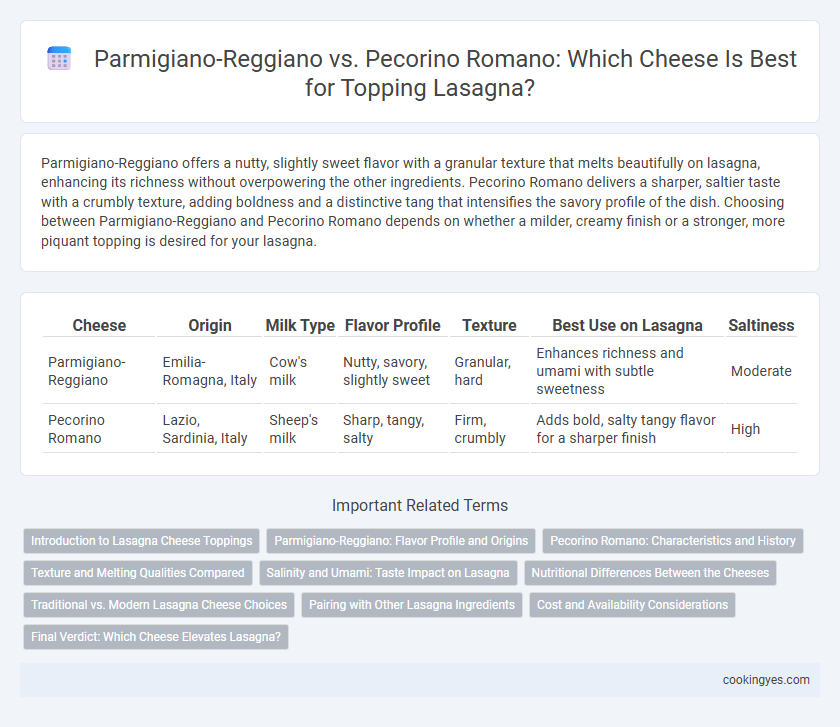Parmigiano-Reggiano offers a nutty, slightly sweet flavor with a granular texture that melts beautifully on lasagna, enhancing its richness without overpowering the other ingredients. Pecorino Romano delivers a sharper, saltier taste with a crumbly texture, adding boldness and a distinctive tang that intensifies the savory profile of the dish. Choosing between Parmigiano-Reggiano and Pecorino Romano depends on whether a milder, creamy finish or a stronger, more piquant topping is desired for your lasagna.
Table of Comparison
| Cheese | Origin | Milk Type | Flavor Profile | Texture | Best Use on Lasagna | Saltiness |
|---|---|---|---|---|---|---|
| Parmigiano-Reggiano | Emilia-Romagna, Italy | Cow's milk | Nutty, savory, slightly sweet | Granular, hard | Enhances richness and umami with subtle sweetness | Moderate |
| Pecorino Romano | Lazio, Sardinia, Italy | Sheep's milk | Sharp, tangy, salty | Firm, crumbly | Adds bold, salty tangy flavor for a sharper finish | High |
Introduction to Lasagna Cheese Toppings
Parmigiano-Reggiano and Pecorino Romano are the two most popular cheese toppings for lasagna, each offering distinct flavors and textures. Parmigiano-Reggiano provides a nutty, savory richness with a granular texture that melts smoothly, enhancing the layers' creaminess. Pecorino Romano delivers a sharper, saltier bite from sheep's milk, adding a bold complexity that balances rich tomato sauces in classic Italian lasagna recipes.
Parmigiano-Reggiano: Flavor Profile and Origins
Parmigiano-Reggiano, known as the "King of Cheeses," offers a rich, nutty, and umami-packed flavor that enhances lasagna's layers with a complex savory depth. Produced exclusively in specific provinces of Italy such as Parma, Reggio Emilia, and Modena, Parmigiano-Reggiano is aged for 12 to 36 months to develop its granular texture and robust taste. Its balanced saltiness and rich aroma make it the preferred topping over Pecorino Romano, which is sharper and saltier, providing a more intense bite but less subtlety.
Pecorino Romano: Characteristics and History
Pecorino Romano, a hard Italian cheese made from sheep's milk, offers a sharp, salty flavor that enhances the savory layers of traditional lasagna. Its origins date back to ancient Rome, where it was prized for its long shelf life and robust taste, making it ideal for grating over pasta dishes. Compared to Parmigiano-Reggiano, Pecorino Romano brings a more pronounced tang and saltiness, adding depth and complexity to the lasagna's topping.
Texture and Melting Qualities Compared
Parmigiano-Reggiano offers a granular texture and melts smoothly, creating a creamy topping that enhances lasagna layers without overpowering flavors. Pecorino Romano has a firmer, crumbly texture and a sharper taste, melting less uniformly and adding a distinct pungency to the dish. Choosing between the two depends on whether a melt-in-silky finish or a robust, slightly grainy topping is preferred for the lasagna.
Salinity and Umami: Taste Impact on Lasagna
Parmigiano-Reggiano offers a balanced umami flavor with moderate salinity, enhancing the rich, savory layers of lasagna without overpowering other ingredients. Pecorino Romano, characterized by higher salinity and a sharper, more pungent umami profile, intensifies the dish's boldness and adds a distinctive salty kick. Choosing Parmigiano-Reggiano results in a smoother, more harmonious taste, while Pecorino Romano delivers a robust, tangy finish that highlights the tomato and meat components.
Nutritional Differences Between the Cheeses
Parmigiano-Reggiano contains higher protein and calcium levels, supporting muscle health and bone strength, while Pecorino Romano offers more sodium and fat, which can impact cardiovascular health. The vitamin A content is greater in Parmigiano-Reggiano, enhancing immune function and vision. Both cheeses provide essential minerals, but their nutritional profiles influence choice based on dietary needs.
Traditional vs. Modern Lasagna Cheese Choices
Parmigiano-Reggiano remains the traditional topping for lasagna, prized for its rich, nutty flavor and granular texture that melts evenly. Pecorino Romano, with its sharper, saltier profile, appeals more to modern variations seeking a bolder taste contrast. Both cheeses elevate lasagna but serve distinctly different roles in balancing authenticity and contemporary flavor innovation.
Pairing with Other Lasagna Ingredients
Parmigiano-Reggiano offers a nutty, savory flavor that complements the rich tomato sauce, bechamel, and layers of tender pasta in lasagna. Pecorino Romano's sharp, salty profile pairs well with robust, meaty fillings like Italian sausage or lamb, enhancing the dish's depth. Combining Parmigiano-Reggiano with Pecorino Romano can balance creaminess and boldness, creating a complex topping that harmonizes with diverse lasagna ingredients.
Cost and Availability Considerations
Parmigiano-Reggiano offers a rich, nutty flavor and is often pricier due to its lengthy aging process and strict regional production in Italy, making it slightly less accessible internationally. Pecorino Romano, made from sheep's milk and produced primarily in Sardinia and Lazio, is generally more affordable and widely available in both grocery stores and specialty cheese shops. Choosing between the two depends on budget constraints and local availability, as Parmigiano-Reggiano can elevate lasagna with depth but may not fit every cost range.
Final Verdict: Which Cheese Elevates Lasagna?
Parmigiano-Reggiano offers a nutty, complex flavor with a granular texture that melts evenly, enhancing lasagna's rich tomato and bechamel layers with subtle umami. Pecorino Romano delivers a sharper, saltier profile derived from sheep's milk, adding boldness and a slightly crumbly texture that cuts through creamy sauces. Parmigiano-Reggiano is often preferred for its balanced depth and meltability, making it the ultimate cheese to elevate traditional lasagna.
Parmigiano-Reggiano vs Pecorino Romano for topping Infographic

 cookingyes.com
cookingyes.com